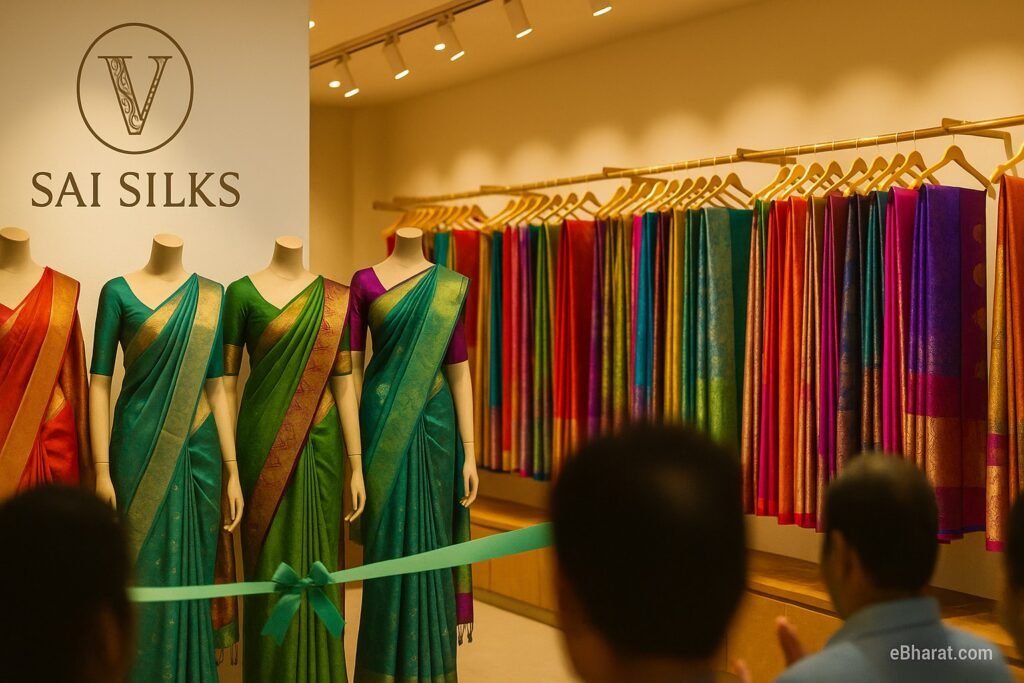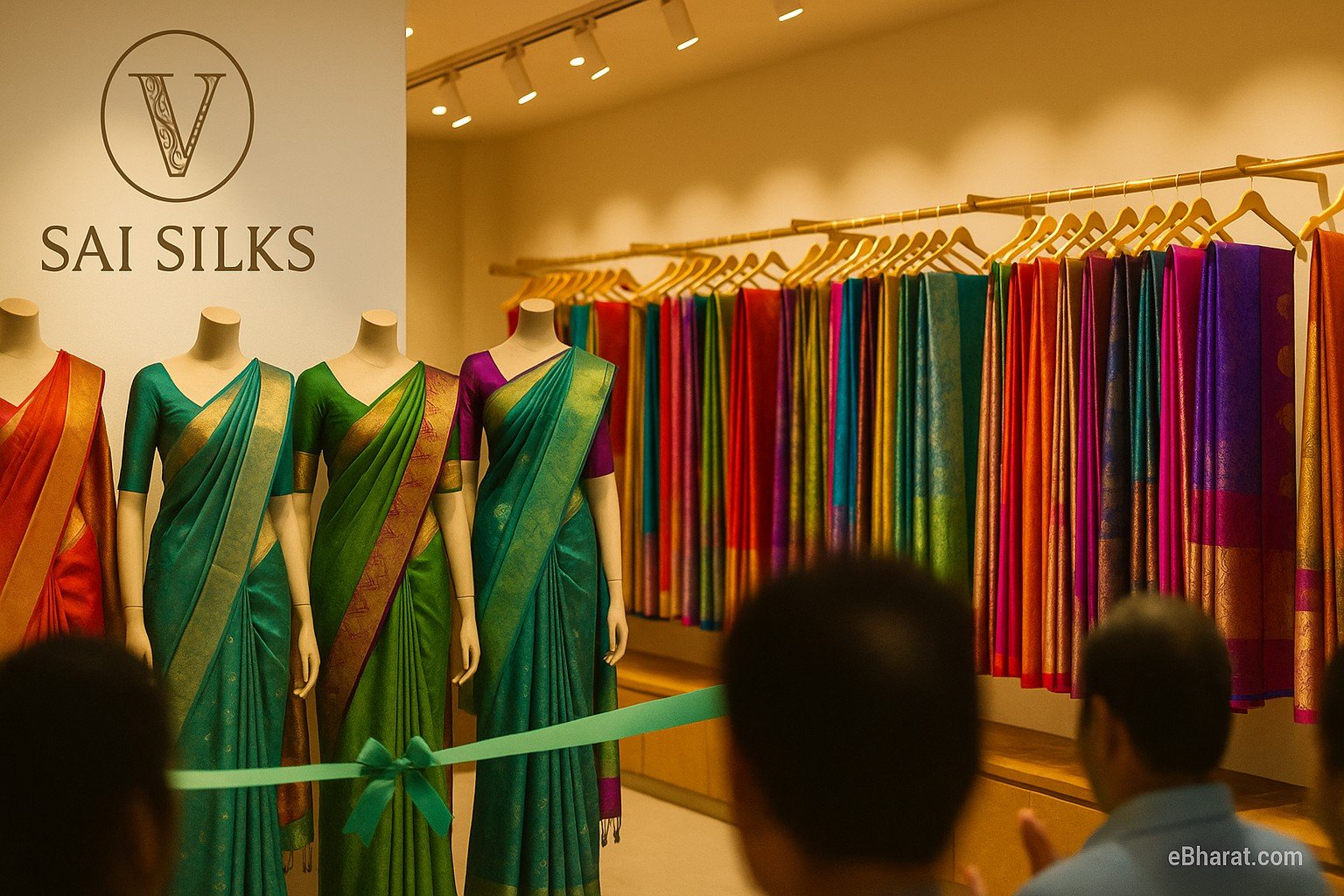
Sai Silks (Kalamandir) Ltd has expanded its premium saree footprint with the launch of its 74th Valli Silks store in Vijayawada, Andhra Pradesh. The company notified the exchanges under SEBI (LODR) Regulation 30, stating that the store opened today and is fully operational. The new outlet strengthens the retailer’s cluster strategy in Coastal Andhra while deepening access to Kanchipuram silks, handloom lines, and contemporary bridal collections under the Valli Silks format.
What’s new — and why it matters
The Vijayawada opening comes ahead of the festive and wedding-heavy October–December quarter, a period that typically drives outsized demand in ethnicwear and sarees. By timing the launch into this window, the company aims to capture early-season footfalls, wedding trousseau shopping, and gifting budgets. Industry checks indicate malls and high-street locations across the South have seen improving traffic, aided by steady urban consumption, rising event calendars, and a return to in-person celebrations.
From a strategy lens, Valli Silks sits at the premium end of Sai Silks’ multi-format playbook (alongside Kalamandir, KLM Fashion Mall, and VaraMahalakshmi). The brand targets discerning saree shoppers who prioritize craftsmanship, heavier zari work, and curated bridal assortments. That mix can lift average selling prices (ASPs) and gross margins compared with value formats, supporting unit economics even as store sizes scale.
Store snapshot
| Metric | Detail |
|---|---|
| New Store Number | 74 (Valli Silks format) |
| City / State | Vijayawada, Andhra Pradesh |
| Format Positioning | Sarees & ethnic occasion wear; bridal/Kanchipuram focus |
| Go-Live | September 29, 2025 |
| Regulatory Basis | Exchange intimation — SEBI LODR Reg-30 |
Expansion logic: cluster economics and omnichannel
Vijayawada bolsters the company’s cluster density across Coastal Andhra and Telangana. Cluster-led expansion reduces logistics and marketing costs, improves staff training/sharing, and supports faster replenishment of fast-moving SKUs. For a saree retailer, proximity also enables curation agility—moving specific colorways, borders, and weave patterns in response to micro-market preferences (wedding palettes, temple festivities, and seasonal ceremonies).
On the channel side, Sai Silks has steadily layered omnichannel capabilities—appointment-led shopping for bridal trousseau, click-and-collect for pre-selected sarees, and live-assisted video shopping for NRI customers. The Vijayawada store is expected to plug into this stack from day one, using digital catalogues and stylist consultations to convert high-ASP baskets while minimizing returns.
What to watch over the next 4–8 weeks
- Footfall & conversion: Weekend traffic and bill-value trends are early indicators of local resonance. Bridal assortments often need high-touch assisted selling; staff productivity and styling services will be key.
- Inventory turns: Premium sarees carry higher ticket sizes but slower turns; balanced buys and active re-ordering are crucial to avoid working-capital drag.
- Marketing mix: Neighborhood outreach (wedding planners, community groups), influencer tie-ups, and festive previews typically amplify opening momentum.
- Omnichannel throughput: Appointment slots filled, virtual consults completed, and click-and-collect share of orders.
- Breakeven cadence: Management has historically targeted swift store breakevens in established clusters; watch rent-to-sales and staff cost ratios versus mature-store benchmarks.
Sector backdrop
Ethnicwear remains relatively resilient within discretionary retail, supported by cultural spending and the rebound in destination weddings. Saree retail has benefited from a broader premiumization trend—customers trading up for heritage weaves, artisanal techniques, and designer collaborations. The organized chains are consolidating share through superior sourcing, standardized experience, and stronger post-purchase services (falls, pico, alterations, blouse design referrals).
For Sai Silks, scale in sourcing across Kanchipuram, Banarasi, and handloom clusters enables differentiated curation and pricing power. The Valli Silks identity—rooted in craftsmanship and bridal storytelling—creates cross-sell opportunities into jewelry, accessories, and family ensemble planning, raising basket sizes and repeat rates.
Risks & mitigants
- Demand variability: A softer festive season, adverse weather, or event cancellations could weigh on footfalls. Mitigant: diversified formats and a wide regional base balance cyclical dips.
- Merchandise risk: Over-indexing on heavy bridal lines may slow turns. Mitigant: disciplined buy plans and data-informed replenishment across price ladders.
- Execution: New-store ramp depends on hiring, training, and local marketing. Mitigant: cluster synergies and shared services accelerate stabilization.
- Working capital: Premium inventory ties up cash. Mitigant: faster re-order cycles, vendor terms, and omnichannel sell-through.
Outlook
The Vijayawada launch underscores management’s confidence in the premium saree opportunity and the effectiveness of a cluster-first expansion model. If early footfall and basket metrics track plan, the store should add meaningfully to festive-quarter revenues. Over the medium term, continued expansion in high-density catchments, coupled with omnichannel scale and curated storytelling, positions Valli Silks to gain share in the organized ethnicwear market.













